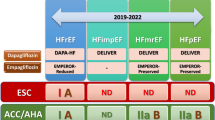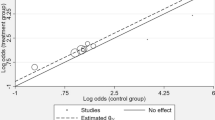Abstract
Mineralocorticoid receptor antagonists (MRAs) are a cornerstone drug class for heart failure therapy. Several clinical studies have demonstrated its role in heart failure therapy. However, due to the recommendation of sodium-glucose cotransporter-2 (SGLT-2) inhibitors for the treatment of heart failure, there is a lack of sufficient evidence regarding whether MRAs can continue to play a cornerstone role in heart failure treatment. A meta-analysis was performed on subgroups of the DAPA-HF and EMPEROR-Reduced trials. Using trial-level data, we performed a meta-analysis to assess the effects of SGLT-2 inhibitors and MRAs on various clinical endpoints of heart failure. The incidence of cardiovascular-related death or heart failure hospitalization was the primary outcome. In addition, we assessed cardiovascular death, all-cause death, heart failure hospitalization, renal outcomes, and hyperkalemia. This study has already been registered with PROSPERO, CRD42022385023. Compared with SGLT-2 inhibitor monotherapy, combined treatment did not demonstrate more significant advantages in terms of heart failure or cardiovascular death (RR = 1.00; 95% CI: 0.78–1.28), cardiovascular death (RR = 0.96; 95% CI: 0.61–1.52), heart failure hospitalization (RR = 0.92; 95% CI: 0.79–1.07), all-cause death (RR = 1.00; 95% CI: 0.63–1.59) and composite kidney endpoint (RR = 0.85; 95% CI: 0.49–1.46). Moreover, in comparison to SGLT-2 inhibitors, combined therapy increased the risk of moderate-severe hyperkalemia (blood potassium > 6.0 mmol/l) (RR = 4.13; 95% CI: 2.23–7.65). In patients with HFrEF who have started MRAs treatment, the addition of an SGLT-2 inhibitor provides significant clinical benefit. However, the addition of MRAs to SGLT-2 inhibitors to treat heart failure is not essential.




Similar content being viewed by others
Availability of data and materials
All data generated or analyzed during this study are included in this published article.
Abbreviations
- eGFR:
-
Estimated glomerular filtration rate
- RR:
-
Rate ratio
- CI:
-
Confidence interval
- SGLT-2:
-
Sodium-glucose co-transporter-2
- MRA:
-
Mineralocorticoid Receptor Antagonists
References
Zinman B, Wanner C, Lachin JM, Fitchett D, Bluhmki E, Hantel S et al (2015) Empagliflozin, cardiovascular outcomes, and mortality in type 2 diabetes. N Engl J Med 373(22):2117–2128
Neal B, Perkovic V, Mahaffey KW, de Zeeuw D, Fulcher G, Erondu N et al (2017) Canagliflozin and cardiovascular and renal events in type 2 diabetes. N Engl J Med 377(7):644–657
Wiviott SD, Raz I, Bonaca MP, Mosenzon O, Kato ET, Cahn A et al (2019) Dapagliflozin and cardiovascular outcomes in type 2 diabetes. N Engl J Med 380(4):347–357
Perkovic V, Jardine MJ, Neal B, Bompoint S, Heerspink HJL, Charytan DM et al (2019) Canagliflozin and renal outcomes in type 2 diabetes and nephropathy. N Engl J Med 380(24):2295–2306
Pitt B, Remme W, Zannad F, Neaton J, Martinez F, Roniker B et al (2003) Eplerenone, a selective aldosterone blocker, in patients with left ventricular dysfunction after myocardial infarction [published correction appears in N Engl J Med 348(22):2271]. N Engl J Med 348(14):1309–1321
Zannad F, McMurray JJ, Krum H, van Veldhuisen DJ, Swedberg K, Shi H et al (2011) Eplerenone in patients with systolic heart failure and mild symptoms. N Engl J Med 364(1):11–21
Pitt B, Zannad F, Remme WJ, Cody R, Castaigne A, Perez A et al (1999) The effect of spironolactone on morbidity and mortality in patients with severe heart failure. Randomized Aldactone Evaluation Study Investigators. N Engl J Med 341(10):709–717
McMurray JJV, Solomon SD, Inzucchi SE, Køber L, Kosiborod MN, Martinez FA et al (2019) Dapagliflozin in patients with heart failure and reduced ejection fraction. N Engl J Med 381(21):1995–2008
Packer M, Anker SD, Butler J, Filippatos G, Pocock SJ, Carson P et al (2020) Cardiovascular and renal outcomes with empagliflozin in heart failure. N Engl J Med 383(15):1413–1424
Zannad F, Ferreira JP, Pocock SJ, Anker SD, Butler J, Filippatos G et al (2020) SGLT2 inhibitors in patients with heart failure with reduced ejection fraction: a meta-analysis of the EMPEROR-Reduced and DAPA-HF trials. Lancet 396(10254):819–829
Heidenreich PA, Bozkurt B, Aguilar D, Allen LA, Byun JJ, Colvin MM et al (2022) 2022 AHA/ACC/HFSA guideline for the management of heart failure: a report of the American College of Cardiology/American Heart Association Joint Committee on Clinical Practice Guidelines [published correction appears in Circulation. 2022 May 3;145(18):e1033] [published correction appears in Circulation. 2022 Sep 27;146(13):e185]. Circulation 145(18):e895–e1032
Yancy CW, Jessup M, Bozkurt B, Butler J, Casey DE Jr, Colvin MM et al (2017) 2017 ACC/AHA/HFSA focused update of the 2013 ACCF/AHA guideline for the management of heart failure: a report of the American College of Cardiology/American Heart Association Task Force on Clinical Practice Guidelines and the Heart Failure Society of America. Circulation 136(6):e137–e161
Vaduganathan M, Claggett BL, Jhund PS, Cunningham JW, Pedro Ferreira J, Zannad F et al (2020) Estimating lifetime benefits of comprehensive disease-modifying pharmacological therapies in patients with heart failure with reduced ejection fraction: a comparative analysis of three randomised controlled trials. Lancet 396(10244):121–128
Vaduganathan M, Docherty KF, Claggett BL, Jhund PS, de Boer RA, Hernandez AF et al (2022) SGLT-2 inhibitors in patients with heart failure: a comprehensive meta-analysis of five randomised controlled trials [published correction appears in Lancet. 2023 Jan 14;401(10371):104]. Lancet 400(10354):757–767
Ferreira JP, Zannad F, Pocock SJ, Anker SD, Butler J, Filippatos G et al (2021) Interplay of Mineralocorticoid Receptor Antagonists and Empagliflozin in Heart Failure: EMPEROR-Reduced. J Am Coll Cardiol 77(11):1397–1407
Shen L, Kristensen SL, Bengtsson O, Böhm M, de Boer RA, Docherty KF et al (2021) Dapagliflozin in HFrEF patients treated with mineralocorticoid receptor antagonists: an analysis of DAPA-HF. JACC Heart Fail 9(4):254–264
Liberati A, Altman DG, Tetzlaff J, Mulrow C, Gotzsche PC, Ioannidis JPA et al (2009) The PRISMA statement for reporting systematic reviews and meta-analyses of studies that evaluate healthcare interventions: explanation and elaboration. BMJ 339:b2700
Pitt B, Kober L, Ponikowski P, Gheorghiade M, Filippatos G, Krum H et al (2013) Safety and tolerability of the novel non-steroidal mineralocorticoid receptor antagonist BAY 94–8862 in patients with chronic heart failure and mild or moderate chronic kidney disease: a randomized, double-blind trial. Eur Heart J 34(31):2453–2463
Tromp J, Ouwerkerk W, van Veldhuisen DJ, Hillege HL, Richards AM, van der Meer P et al (2022) A systematic review and network meta-analysis of pharmacological treatment of heart failure with reduced ejection fraction [published correction appears in JACC Heart Fail. 2022 Apr;10(4):295–296]. JACC Heart Fail 10(2):73–84
De Marzo V, Savarese G, Tricarico L, Hassan S, Iacoviello M, Porto I et al (2022) Network meta-analysis of medical therapy efficacy in more than 90,000 patients with heart failure and reduced ejection fraction. J Intern Med 292(2):333–349
Vardeny O, Claggett B, Anand I, Rossignol P, Desai AS, Zannad F et al (2014) Incidence, predictors, and outcomes related to hypo- and hyperkalemia in patients with severe heart failure treated with a mineralocorticoid receptor antagonist. Circ Heart Fail 7(4):573–579
Vardeny O, Wu DH, Desai A, Rossignol P, Zannad F, Pitt B et al (2012) Influence of baseline and worsening renal function on efficacy of spironolactone in patients With severe heart failure: insights from RALES (Randomized Aldactone Evaluation Study). J Am Coll Cardiol 60(20):2082–2089
Rossignol P, Dobre D, McMurray JJ, Swedberg K, Krum H, van Veldhuisen DJ et al (2014) Incidence, determinants, and prognostic significance of hyperkalemia and worsening renal function in patients with heart failure receiving the mineralocorticoid receptor antagonist eplerenone or placebo in addition to optimal medical therapy: results from the Eplerenone in Mild Patients Hospitalization and Survival Study in Heart Failure (EMPHASIS-HF). Circ Heart Fail 7(1):51–58
Arima S, Kohagura K, Xu HL, Sugawara A, Abe T, Satoh F et al (2003) Nongenomic vascular action of aldosterone in the glomerular microcirculation. J Am Soc Nephrol 14(9):2255–2263
Lopaschuk GD, Verma S (2020) Mechanisms of cardiovascular benefits of Sodium Glucose Co-Transporter 2 (SGLT2) Inhibitors: a state-of-the-art review. JACC Basic Transl Sci 5(6):632–644
Griffin M, Rao VS, Ivey-Miranda J, Fleming J, Mahoney D, Maulion C et al (2020) Empagliflozin in heart failure: diuretic and cardiorenal effects. Circulation 142(11):1028–1039
McDonagh TA, Metra M, Adamo M, Gardner RS, Baumbach A, Böhm M et al (2021) ESC Guidelines for the diagnosis and treatment of acute and chronic heart failure [published correction appears in Eur Heart J. 2021 Oct 14]. Eur Heart J 42(36):3599–3726
Dekkers CCJ, Sjöström CD, Greasley PJ, Cain V, Boulton DW, Heerspink HJL (2019) Effects of the sodium-glucose co-transporter-2 inhibitor dapagliflozin on estimated plasma volume in patients with type 2 diabetes. Diabetes Obes Metab 21(12):2667–2673
Cherney DZ, Perkins BA, Soleymanlou N, Maione M, Lai V, Lee A et al (2014) Renal hemodynamic effect of sodium-glucose cotransporter 2 inhibition in patients with type 1 diabetes mellitus. Circulation 129(5):587–597
Eickhoff MK, Dekkers CCJ, Kramers BJ, Laverman GD, Frimodt-Møller M, Jørgensen NR et al (2019) Effects of dapagliflozin on volume status when added to renin-angiotensin system inhibitors. J Clin Med 8(6):779
Zanchi A, Burnier M, Muller ME, Ghajarzadeh-Wurzner A, Maillard M, Loncle N et al (2020) Acute and chronic effects of SGLT2 inhibitor empagliflozin on renal oxygenation and blood pressure control in nondiabetic normotensive subjects: a randomized, placebo-controlled trial. J Am Heart Assoc 9(13):e016173
Isshiki M, Sakuma I, Hayashino Y, Sumita T, Hara K, Takahashi K et al (2020) Effects of dapagliflozin on renin-angiotensin-aldosterone system under renin-angiotensin system inhibitor administration. Endocr J 67(11):1127–1138
Acknowledgements
Not applicable.
Funding
This study was supported by the Natural Science Foundation of China (no. 81700321).
Author information
Authors and Affiliations
Contributions
XG and JZ has participated in study design, literature search, data collection, data analysis/interpretation, and drafting of the manuscript. GC, GZ and SC participated in content guidance and critical revision of the paper for important intellectual content. ZN, WL and TG participated in literature search and revision. YZ and BL supervised the work and revised the article critically. All authors have read and approved the submission of the manuscript, which has not been published and is not being considered for publication elsewhere in whole or part in any language.
Corresponding authors
Ethics declarations
Conflict of interest
The authors declare no conflict of interest.
Ethics approval and consent to participate
Not applicable.
Additional information
Publisher's Note
Springer Nature remains neutral with regard to jurisdictional claims in published maps and institutional affiliations.
Supplementary Information
Below is the link to the electronic supplementary material.
Rights and permissions
Springer Nature or its licensor (e.g. a society or other partner) holds exclusive rights to this article under a publishing agreement with the author(s) or other rightsholder(s); author self-archiving of the accepted manuscript version of this article is solely governed by the terms of such publishing agreement and applicable law.
About this article
Cite this article
Guan, X., Zhang, J., Chen, G. et al. MRAs may have lost their cornerstone position for heart failure treatment in the age of SGLT-2 inhibitors: A meta-analysis of randomized controlled trials. Heart Fail Rev 28, 1427–1436 (2023). https://doi.org/10.1007/s10741-023-10330-5
Accepted:
Published:
Issue Date:
DOI: https://doi.org/10.1007/s10741-023-10330-5




